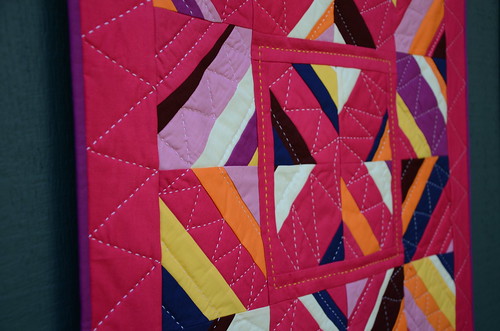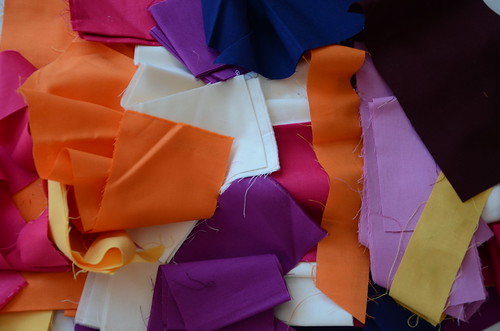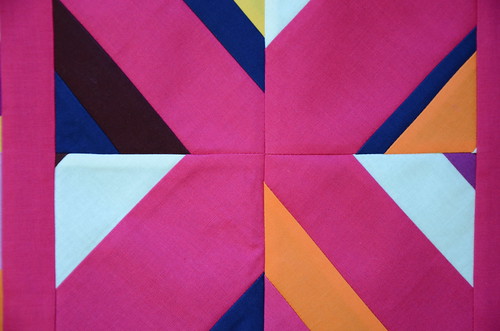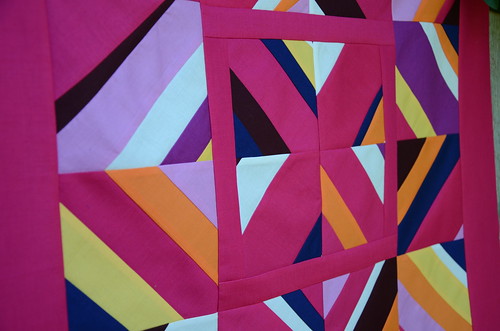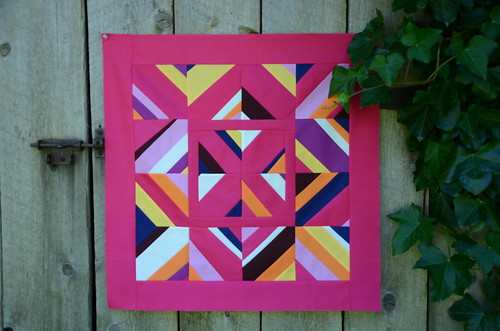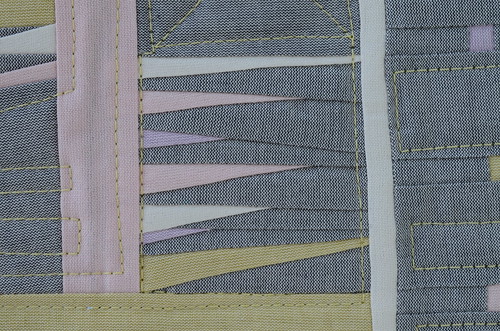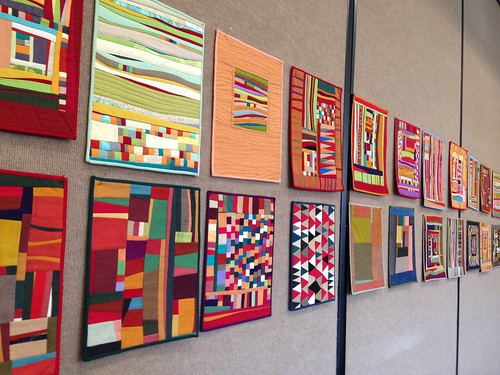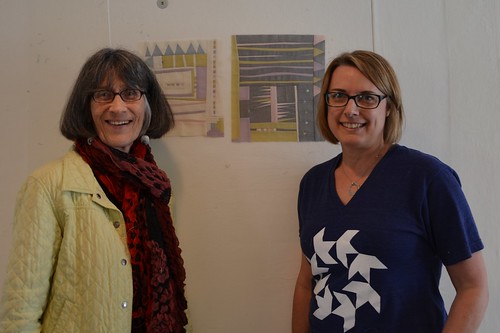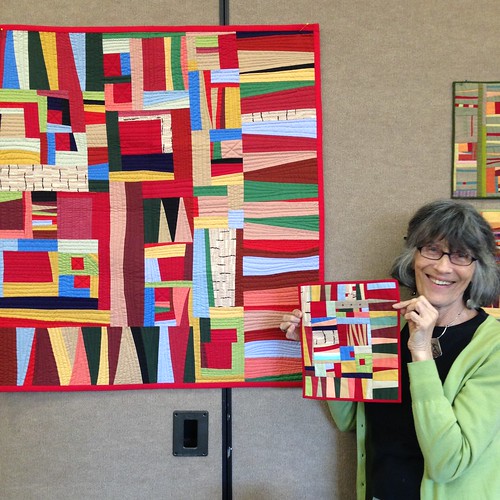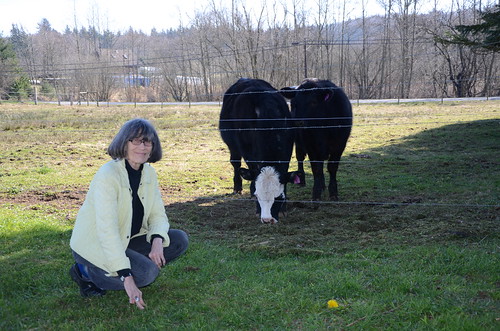Do you have a quilting idol? I do. Her name is Gwen Marston. When I first took the book
Liberated Quiltmaking (first published in 1997, but re-issued twice since then) out of my guild library about 10 years ago, I was immediately enthralled by the photographs and technique illustrations. Her work was unlike any I'd ever seen. There was a folk art/Amish/Gees Bend charm to her quilts that captivated me. I admired each photograph and hoped that one day I would have the technical confidence to try my hand at such a different style of quilting.
Quilts and hand quilting by Gwen Marston
In my opinion, Gwen, and possibly a few others like her, paved the way for so much of the modern quilt making movement that is steam rolling through the quilt world and internet today. Solids? Stitch and flip corners? Slice and insert strips? Wonky strip borders? Improv triangles? Wonky stars? Alternate grid patterns? Liberated medallions? She was doing it all in the late 90's.
Every one of her many books is an inspiration and an illustrated guide to her quilt making journey from folk art quilts to improvisational masterpieces. I cannot recommend every one of them enough.
Liberated Medallion Quilts and
37 Sketches are my two favs.
Minimal Quiltmaking is also a visual treat.
I was sad to learn Gwen had given up her Beaver Island, MI week-long quilting retreats two years ago as it had been my hope to attend one at some point. Occasionally I would hear about her teaching workshops in the Seattle area but the timing never seemed to work out for me. Finally, this past weekend, I got to spend two days with Gwen. Two of the best days of my quilting quest to date.
A portion of Gwen's 37 Sketches exhibit
The first day workshop was called Small Studies and was based on Gwen's 37 Sketches work. She brought about 2/3 of her sketch quilts with her for us to admire and taught us some of her working small techniques. We spent the better part of a day sewing with nothing larger than 3/4" to 2 1/4" strips. I never work that small! She demonstrated her techniques for achieving wavy, skinny inset strips, impossibly skinny/pointy spikes, inset tiny squares and improv equilateral triangles. When she pieces 1/4" finished checkerboards, they are not strip-pieced and cross-cut. Oh no. Gwen keeps 3/4" squares in "a beautiful antique Spode dish" beside her Featherweight (all of her quilts are sewn on a Featherweight and hand-quilted) because they look so pretty and they are so fun to sew together. Seriously, I could have hugged her about 10 times that day.
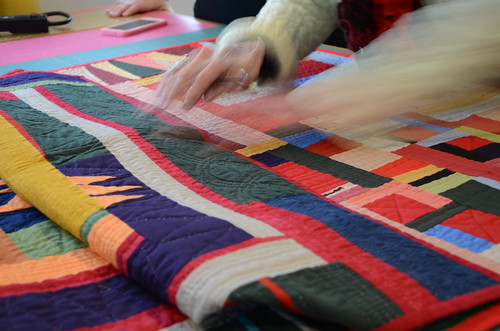
Gwen talks about her various binding techniques. These quilts are finished in the style she learned from the Mennonite women. The finished edge is about 1/2" wide. Two opposite sides are bound first, then the other sides are bound and raw edges tucked under at the corners.
"I had to be brave when I made this one [indicating the center block] - this is not the most exciting block, but the triangles in that radical colour combination? And those red circles?...I didn't know how those were going to work out!"
She quilts without marking "so that the lines tell their own story...and isn't that more interesting?"
I wish I had a tape recording of some of my favourite quotes from Gwen, like "save everything, it might come in handy later", or "cut from the straight of the goods", or "ask me if I care about show bindings". Everyone was encouraged. Everyone felt their work was valid and progressing. She's a pro. I could not be more happy that she's been recognized by the Modern Quilt Guild and invited to be the Keynote Speaker at QuiltCon 2016 in Pasadena, CA. Gwen's a completely relaxed and comfortable teacher; her years of experience and sharing are evident. She credits the Mennonite women that invited her in and taught her the power of sharing years ago when, as a young mother, she found herself in a new town without quilting friends. She also spoke about her inspiring friends Jean Wells and Freddy Moran and the projects they have done together, sharing ideas while respecting each other's style and direction.
Gwen and I with my two small studies on the design wall.
I made a point to try each of the piecing techniques Gwen had demonstrated and use them to create two small studies of my own. They'd represent a diary of sorts from my days with Gwen. The second day was very special as there were only 10 of us sewing with Gwen in a private studio on a rural farm just south of the border. I continued my work from the previous day and complete two small quilt tops not much larger than a piece of paper. I used the brand new Oakshott Scandinavia shot cottons that I had received from Oakshott recently. This is an unusual palette for me and I love the results. The subtlety of the fabrics let me focus more on technique and shape and removed the added mental energy of worrying about putting bolder colour combinations together. That can come later!
Quilt and hand quilting by Gwen Marston. Black thread! Why not?
Small study & it's big sister, with Gwen
I loved that Gwen shared two of her "big sister" quilts that evolved from her small studies. She is working only small these days, nothing larger than about 30-40" square. She hand quilts all of her work and says anything larger is just too cumbersome in her hoop. Plus, her house is stuffed with quilts and she finds it easier to travel with just one suitcase of quilts when she's teaching now. She was very interested and asked a lot of questions about machine quilting that "the moderns" are doing. By the time she got about 10 sketches into her 37, she stopped quilting them entirely and just bound the small quilt sandwiches with a single fold binding.
Gwen explains that this entire quilt was made from tossed scraps she salvaged from one of Beaver Island week long retreats.
I feel so incredibly lucky that I had these two days to learn so much from Gwen, to see her work in person and to finally hug my quilting idol. She's the bees knees. And she likes cows.


